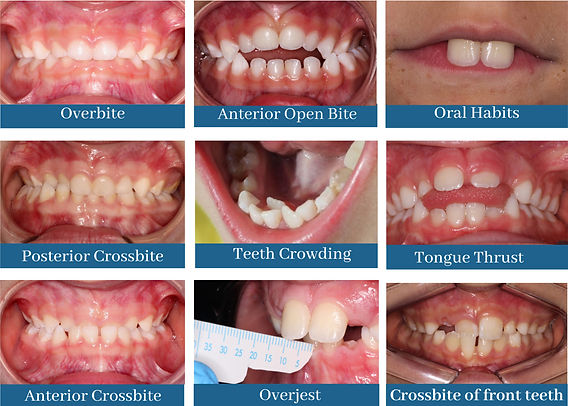Introduction
Malocclusion is when your teeth don’t fit together as they should. It’s not just about looks—it can make eating and speaking difficult, too. It can also affect how you feel about yourself because of its impact on your smile. Understanding what malocclusion is will help you make better choices for your teeth and gums. Think of it as laying the foundation for a healthier mouth! The more you know about malocclusion, the better you can take care of your oral well-being. Knowing about this can also help in preventing related issues like crossbites, deep bites, or open bites, making everyday life just that bit smoother.
What is Malocclusion and Its Impact?
Malocclusion means “bad bite”. It’s when your teeth, top and bottom, don’t line up. There are three main types:
- Class 1: Teeth are crowded but arranged in a good alignment
- Class 2: The upper teeth stick out over the lower ones, sometimes known as an overbite
- Class 3: The lower teeth are ahead of the upper teeth, appearing like an underbite
All these classifications can cause problems. They can make it hard to chew your favorite foods or say words clearly. This can hurt your confidence and how you interact with others. And that’s the last thing anyone needs! So, knowing about these types can help you understand which could be affecting you. It might help explain why you sometimes avoid smiling wide in photos or find chewing certain foods tricky.
Unveiling the Causes of Malocclusion
he reasons behind malocclusion can be fascinating. Often, it’s just something we’ve inherited from our families. Sometimes, our jaw is just too small, or our teeth are too big! Those childhood habits like thumb-sucking or using a pacifier for too long can affect tooth alignment. They might cause what’s known as a deep bite, making front teeth come down too far over bottom teeth.
Dental issues such as losing baby teeth too early can also lead to this “bad bite” issue. Certain medical conditions that affect facial muscles can be sneaky troublemakers too. All these factors illustrate how important early awareness and healthy habits are. It might seem surprising, but just growing up can sometimes shift our teeth in ways we don’t expect.
Why Early Intervention Matters
You may wonder why acting now on malocclusion is crucial. If left unchecked, it can cause more than a crooked smile. Problems like tooth decay or gum disease can eventually arise. The earlier you catch it, the better. Early diagnosis can save time and money, sparing you from costly treatments down the road.
This issue is also tied to overall health—good bites equal good basics! Sorting these dental issues out early can prevent headaches, jaw pain, or poor digestion from improper chewing. Plus, think about the savings! Preventive care is often much cheaper than treatments. Catching malocclusion in its tracks can mean less worry and more smiles.
Proven Strategies for Prevention
Preventing malocclusion starts early. During childhood, it’s good to keep an eye on habits like:
- Limiting pacifier use and thumb sucking
- Encouraging regular dental check-ups
- Promptly dealing with cavities and other dental issues
It’s crucial that parents and caregivers help manage these habits to avoid the onset of crossbites or deep bite troubles down the line. As kids grow, allergies and breathing issues should be handled carefully since they can impact mouth and teeth alignment.
Adults should also remain vigilant. Regular dental visits can nip potential problems in the bud. Don’t underestimate the power of a consistent dental care routine. Small actions like these count a lot towards preventing big dental problems.
Local Context: Malocclusion Prevalence
How common is malocclusion around us? Perhaps more than you thought! Locally, it’s often seen as early as childhood. Globally, the differences in types like crossbite or overjet aren’t vast. However, awareness and early treatment practices do vary. It’s important to know where your community stands compared to others to gauge when to act.
Parental Role in Early Identification
Parents play a huge role in spotting malocclusion early. Watching out for early signs or changes in your child’s teeth can be pivotal. Keep an eye for teeth that don’t “quite fit” or difficulties with chewing.
For timely intervention: – Schedule regular dental visits – Ask questions if you spot changes
These actions might just prevent those smaller issues from turning into bigger ones later.
Exploring Treatment Options
Fixing malocclusion can involve various treatments. Sometimes, simple braces will do the trick. In more complex cases, surgical options may be considered.
- Non-surgical treatments include traditional braces or clear aligners.
- Surgical options might involve changing the position of the jaw.
Orthodontic evaluations are key. They ensure you get just the right treatment. It’s good to know that every mouth is unique and might need a different approach for the best outcomes.
Conclusion: Empowering Dental Health Awareness
Malocclusion might sound complex, but it’s a dental issue you can manage with the right strategies. Recognizing and acting early can prevent bigger problems. Prioritize regular check-ups and friendly dental discussions. Empower yourself and your family by taking charge of your dental health today! Encouragement goes a long way in ensuring bright, healthy smiles for everyone.


